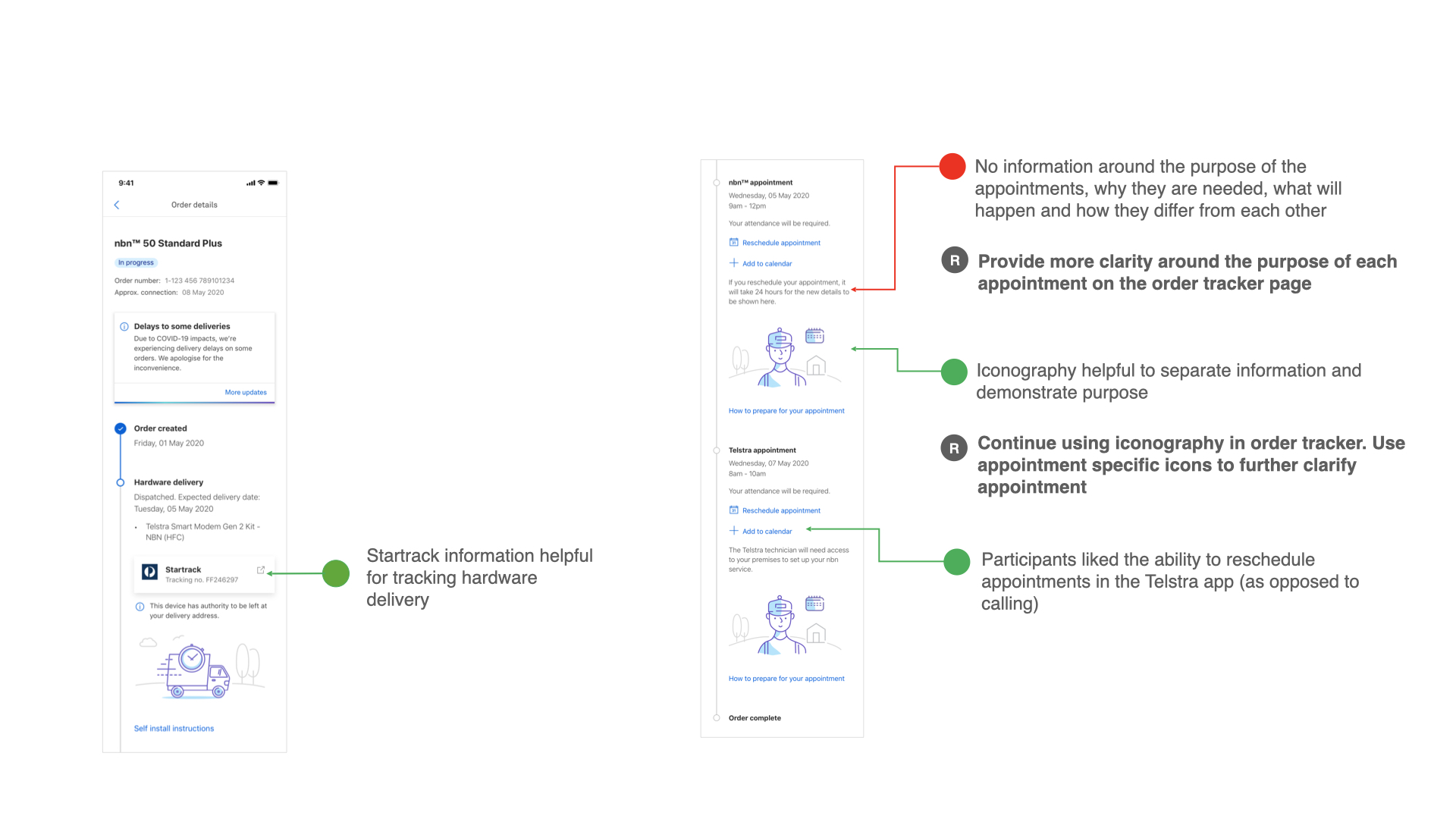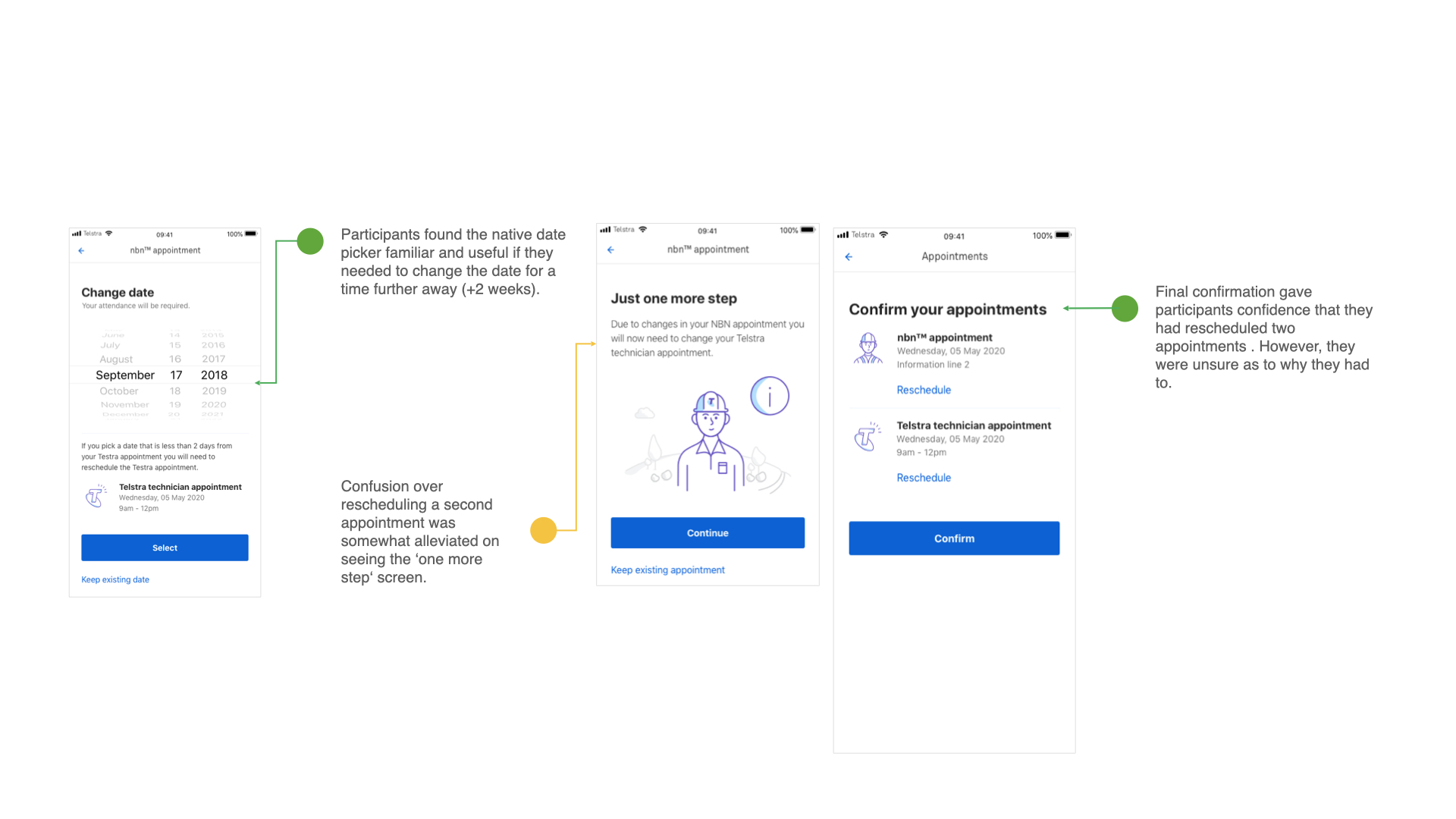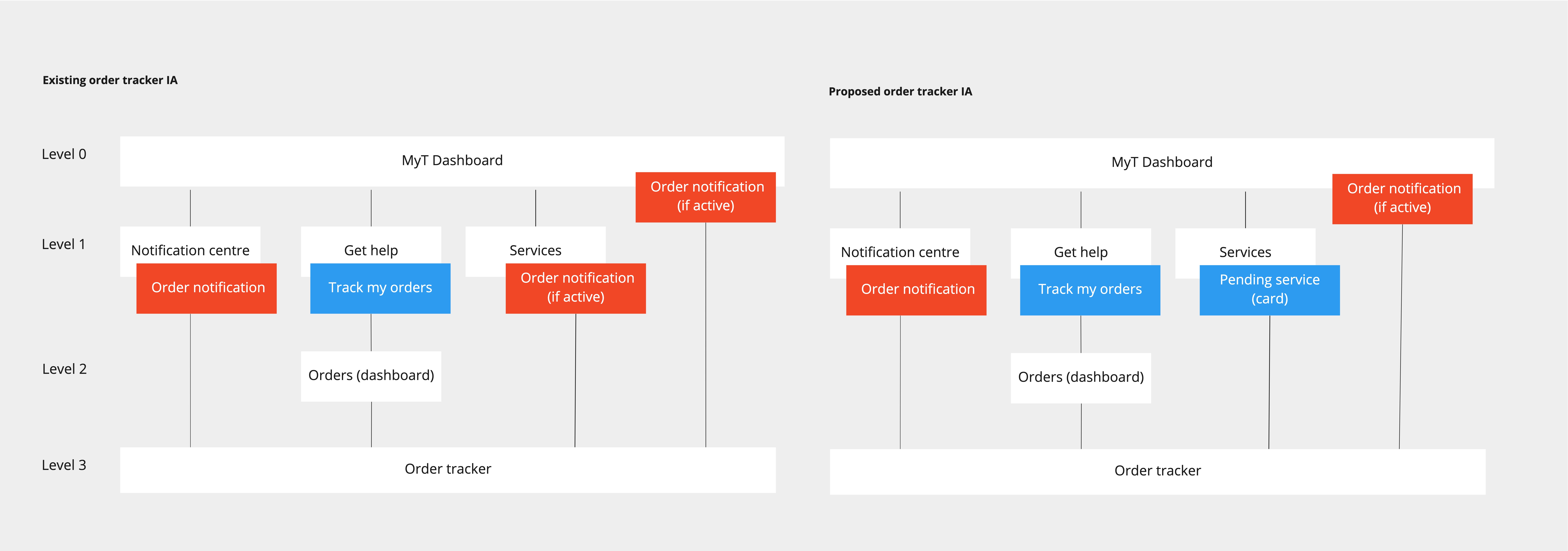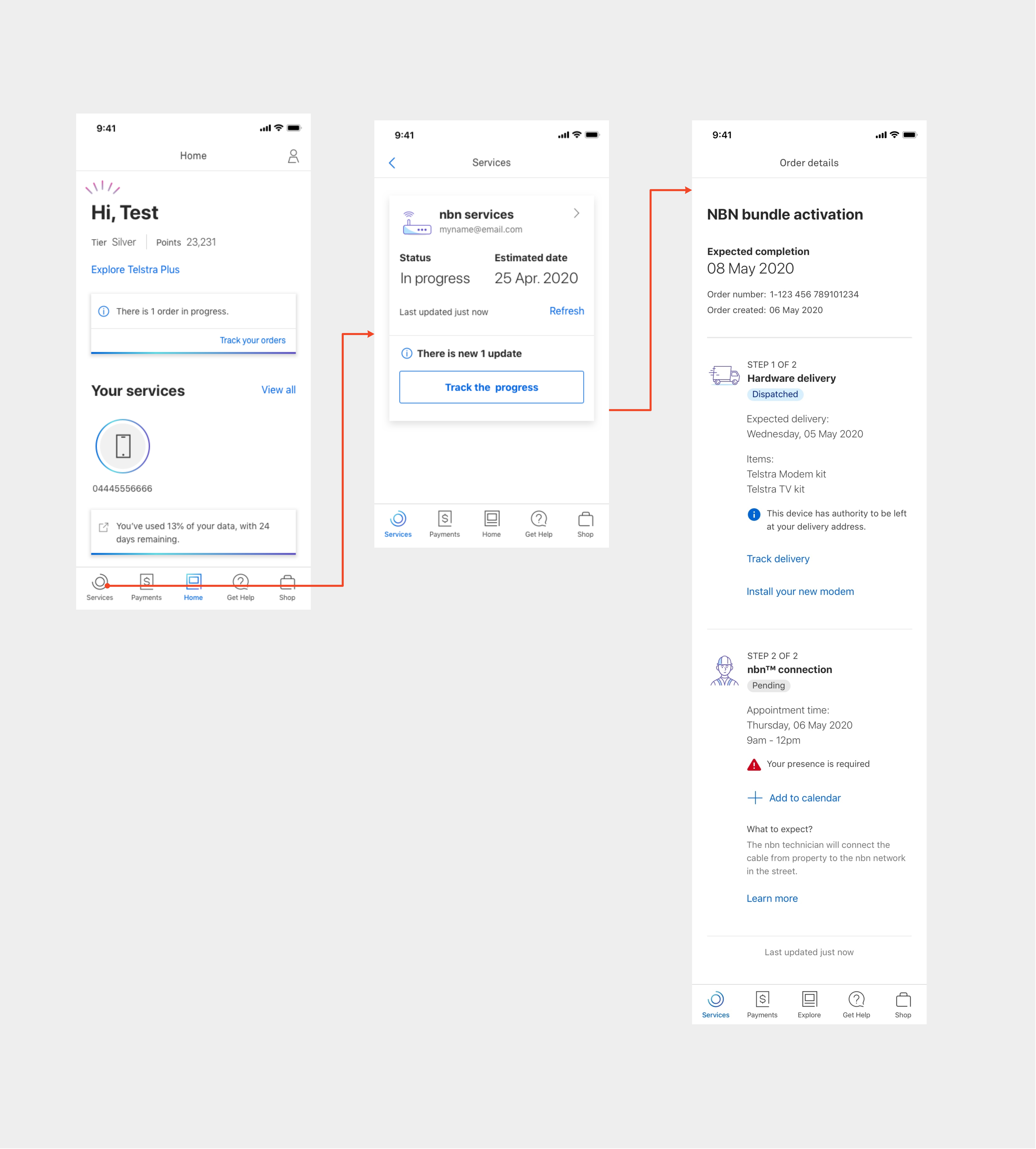My Telstra app allows cunsumer to manage their nbn and mobile services in a native mobile experience. Users can check the status of their NBN order, manage their related appointments and change their NBN plan in the MyTelstra app.
Problem
The order tracking experience in the MyTelstra app was outdated. Designs were taken from the old world and re-skinned to look and feel native.
Additionally, limited thought had been put in the overall MyTelstra order tracking experience and how to cater towards many different services, scenarios and actions.
Goals
- Uncover pain points and potential opportunities in the existing customer journey.
- Understand the mental models customers have to different order tracking scenarios.
- Create a user journey which caters towards these mental models, allowing intuitive access and use.
- Optimise the order tracker page to enhance accessibility, the information architecture, typographic hierarchy and overall ease of use to allow for quick digestion by the customer.
Problem
The order tracking experience in the MyTelstra app was outdated. Designs were taken from the old world and re-skinned to look and feel native.
Additionally, limited thought had been put in the overall MyTelstra order tracking experience and how to cater towards many different services, scenarios and actions.
- Uncover pain points and potential opportunities in the existing customer journey.
- Understand the mental models customers have to different order tracking scenarios.
- Create a user journey which caters towards these mental models, allowing intuitive access and use.
- Optimise the order tracker page to enhance accessibility, the information architecture, typographic hierarchy and overall ease of use to allow for quick digestion by the customer.
![]()
Summary
The scope of the project was to create a unified order tracking experience across different Telstra services, allowing customers to intuitively access the order tracker during their unique journey.
There was a vast number of services and scenarios this catered for, e.g. handset delivery, moving house, organising a technician to set up your internet.
The main objective of the research has been to understand customer mental models associated with these differing scenarios to design an optimised overall experience and enhanced order tracker page design that allows for quick and easy digestion of key information.
To understand customer use cases, an exploratory research has been conducted through:
- Survey
- User interviews
- Treejack test
This enabled better understand users expectations on the overall experience for the order tracker as well as understand the individual nuances of each individual scenario and the mental models users have towards the different scenarios.
The research demonstrated a need to build an experience that catered towards different mental models and opened the path to further work on optimising entry points into the order tracker and reviewing the information architecture.
MyTelstra Agile squads
MyTelstra consists of numerous Agile squads focused on launching features and functionality into the app.
The squads were required to release features quickly. Collaboration and information sharing was fundamental to ensure consistency and avoid loss and duplication of work across squads.
I have been instrumental in championing design operations across design teams with the systematic and persistent gathering of past research, backend functionality and solutions.
On the development side, it was crucial to understand the backend systems to have understood what we can currently deliver and what we can push to deliver in future releases.
Understanding the backend constraints and maintaining consistent and open communication with developers and solution engineers ensured the team were able to deliver customer-centric solutions in tight timeframes.
Survey
A survey targeting Telstra NBN customers uncovered pain points in the customer journey specially around the technician appointment and the modem self-installation.
To ensure the relevancy of the data collected the survey sample has been compared and weighted against the Telstra Business Persona Profiles.
The research highlighted that 40% of the surveyed participants are not familiar with the NBN activation process.
Around 30% of the participants that defined themself familiar with the process were not able to describe it correctly.
The research also helped to define user goals around the order tracker and nbn activation experience:
- Reschedule appointment
-
Device/package delivery updates
-
Activation & self install help
- Technical support
User interviews
A prototype has been tested with participants to understand how they navigate through specific flows and potential pain/gain points.
User testing sessions has been performed to investigate assumptions on customers differing mental models and test design aspects such as usability, find-ability and expectations of the flow.
Participants were recruited through the online Askable platform, for a mix of demographics based on personas profiles.
Each participant was presented with task-based scenarios and asked to complete them using the prototype.
The key outcomes from this round of testing were:
1. Users require clarity around the ‘why’ and purpose of key events stated on the order tracker that Telstra impose on them.
2. Users require language to be customer-centric and easily digestible, not in confusing “business language”
3. Users would expect to see a notification regarding plan changes or key milestones regarding their order. They would not intuitively navigate to the order tracker for scenarios other than physical delivery.
4. Iconography is powerful in helping users quickly and easily digest the meaning of each milestone.




The participants were tasked to find their NBN appointments in the app and 60% of the users fault to accomplish the task under the existing flow.
Participants also mentioned that for hardware tracking and appointments, there was an expectation of receiving ‘notifications’ mimicking the pattern of receiving email notifications for these types of events e.g. doctor’s appointment, package delivery.
Instead for appointments and plan changes there was a high usage of the 'services section', however it was difficult for participants to find exactly what they wanted within this.
Instead for appointments and plan changes there was a high usage of the 'services section', however it was difficult for participants to find exactly what they wanted within this.

KEY DATA
Hardware delivery
67% of participants would rely on the notification centre for this scenario
31% of participants ‘visited’ the services section to look for the order tracker
Appointment tracking
53% of participants would rely on the notification centre for this scenario
62% of participants visited the services section
Hardware delivery
67% of participants would rely on the notification centre for this scenario
31% of participants ‘visited’ the services section to look for the order tracker
Appointment tracking
53% of participants would rely on the notification centre for this scenario
62% of participants visited the services section
Tree Jack testing
The insights collected in the user interviews demonstrated the differing mental models and the need for improved information architecture.
Customers hold a different mental model for tracking hardware, appointments and changing plan.
Further validation from a larger number of users has been necessary to provide stakeholders with statistical confidence to make these changes.
Tree jack testing was performed with 205 participants with the goals of:
-
Validating our insight that tracking a physical package, changing (upgrade/downgrade) a plan and appointments (NBN / Telstra technician) are separate within customers mental model
- Validate the need to add additional entry points to the order tracker under ‘services’ to cater for these differing mental models, and reduce reliance on notifications.
Participants indicated that they perceive order tracking to be associated with something physical such as a modem (73%) or handset (68%) as opposed to a plan change (22%) or appointment (40%).
The assumption of differing mental models for tracking hardware, appointments and changes was further validated.

Whilst part of the process of setting up a new NBN plan for customers’ mental model, the appointment is not necessarily aligned with the order.

For each scenario (hardware, appointment, plan change) the customer journey through the MyTelstra IA is different and therefore the mental model for each order type differs.
When building a singular order tracker that caters to multiple distinct events, we must consider:
-
Catering entry points to different events
-
Labelling, IA and UI at important points of the track order experience
- Up-to-date, ‘hyper relevant’ status of the order experience

67%
of users rely on the notification centre 31%
of users visit the services section to look for the order tracker.Improved userflow
A new userflow has been designed allowing the user to access to the NBN order tracker via the service summary screen. As result the users were able to navigate the order tracker.

User interface A/B testing
The user interface I has been uplifted by removing unnecessary visual elements and create delight while ensuring high accessibility standards.
User interface optimisations were made, such as reordering the typographic hierarchy to highlight important information.
The large illustration has been removed and replace by smaller pitcogram next to milestones creating a clear relationship between text and visual and reducing the page scroll were made.
![]()
The large illustration has been removed and replace by smaller pitcogram next to milestones creating a clear relationship between text and visual and reducing the page scroll were made.

The 'progress line' has been also removed. Whilst removing it would give us major wins in terms of accessibility by increasing text size and reduce the burden on screen readers, some felt removing the line would take away the 'linearity' of the process.
Through A/B testing, it has been possible validate that the line has no impact on the perception of linearity, instead a clearly labelling 'Step 1, Step 2' has a more positive impact.
Illustrations has also been used to give visual feedbacks on the status of the order when it is successfully completed, cancelled or this is an issue with it.
A holistic and intuitively order tracker experience has been delivered through an iterative process of customer testing.
The templatised page design allows for any future scenario to be covered reducing design and development time in the future.
NBN appointment
Additonal userflow has been designed and tested to allow users to reschedule their NBN appointment.
Appointments are necessary for Telstra to ensure working internet is delivered to a customer. However, appointments are additional steps that require a high amount of customer involvement and as such are often a major pain point in the NBN installation flow.
In order to minimize this pain, the process needs to be transparent in explaining why these appointments are being held and allowing the users to reschedule the appoitments.

Iconography helpful to separate information and demonstrate purpose. Participants also liked the ability to reschedule appointments in the app.

Participants found the native date picker familiar and useful if they needed to change the date for a time further away (+2 weeks).

Final confirmation gave participants confidence that they had rescheduled the appointment successfully.

Participants found the timeslots expressed as a list expected and straightforward to understand
NBN plan
For a customer to make an informed decision on changing their plan they need critical plan information to be displayed in customer centric terms.
Customers only expect to see critical, relevant information to their NBN plan. When changing plans customers rely on information that can help them make an informed decision such as; current data usage, prices, data amount and speeds.
When we present this information to the customer it is essential that it is displayed in a way that makes sense to them and can be easily interpreted and compared.
The content hierarchy designed to display information that is more relevant to NBN plans and reduces business-specific language by turning features such as speeds into customer-centric terminology that can be easily understood and perceived.
“I expect to see data and usage, the speed, average upload speed, average download speed, type of NBN”


